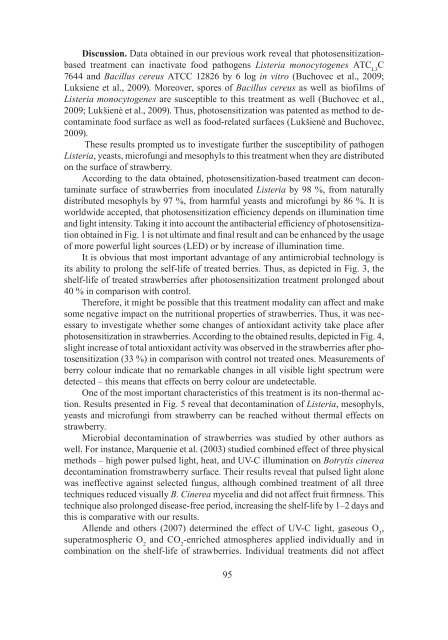SodininkyStÄ ir darŽininkyStÄ 28(4)
SodininkyStÄ ir darŽininkyStÄ 28(4)
SodininkyStÄ ir darŽininkyStÄ 28(4)
Create successful ePaper yourself
Turn your PDF publications into a flip-book with our unique Google optimized e-Paper software.
Discussion. Data obtained in our previous work reveal that photosensitizationbased<br />
treatment can inactivate food pathogens Listeria monocytogenes ATC L3<br />
C<br />
7644 and Bacillus cereus ATCC 1<strong>28</strong>26 by 6 log in vitro (Buchovec et al., 2009;<br />
Luksiene et al., 2009). Moreover, spores of Bacillus cereus as well as biofilms of<br />
Listeria monocytogenes are susceptible to this treatment as well (Buchovec et al.,<br />
2009; Lukšienė et al., 2009). Thus, photosensitization was patented as method to decontaminate<br />
food surface as well as food-related surfaces (Lukšienė and Buchovec,<br />
2009).<br />
These results prompted us to investigate further the susceptibility of pathogen<br />
Listeria, yeasts, microfungi and mesophyls to this treatment when they are distributed<br />
on the surface of strawberry.<br />
According to the data obtained, photosensitization-based treatment can decontaminate<br />
surface of strawberries from inoculated Listeria by 98 %, from naturally<br />
distributed mesophyls by 97 %, from harmful yeasts and microfungi by 86 %. It is<br />
worldwide accepted, that photosensitization efficiency depends on illumination time<br />
and light intensity. Taking it into account the antibacterial efficiency of photosensitization<br />
obtained in Fig. 1 is not ultimate and final result and can be enhanced by the usage<br />
of more powerful light sources (LED) or by increase of illumination time.<br />
It is obvious that most important advantage of any antimicrobial technology is<br />
its ability to prolong the self-life of treated berries. Thus, as depicted in Fig. 3, the<br />
shelf-life of treated strawberries after photosensitization treatment prolonged about<br />
40 % in comparison with control.<br />
Therefore, it might be possible that this treatment modality can affect and make<br />
some negative impact on the nutritional properties of strawberries. Thus, it was necessary<br />
to investigate whether some changes of antioxidant activity take place after<br />
photosensitization in strawberries. According to the obtained results, depicted in Fig. 4,<br />
slight increase of total antioxidant activity was observed in the strawberries after photosensitization<br />
(33 %) in comparison with control not treated ones. Measurements of<br />
berry colour indicate that no remarkable changes in all visible light spectrum were<br />
detected – this means that effects on berry colour are undetectable.<br />
One of the most important characteristics of this treatment is its non-thermal action.<br />
Results presented in Fig. 5 reveal that decontamination of Listeria, mesophyls,<br />
yeasts and microfungi from strawberry can be reached without thermal effects on<br />
strawberry.<br />
Microbial decontamination of strawberries was studied by other authors as<br />
well. For instance, Marquenie et al. (2003) studied combined effect of three physical<br />
methods – high power pulsed light, heat, and UV-C illumination on Botrytis cinerea<br />
decontamination fromstrawberry surface. The<strong>ir</strong> results reveal that pulsed light alone<br />
was ineffective against selected fungus, although combined treatment of all three<br />
techniques reduced visually B. Cinerea mycelia and did not affect fruit f<strong>ir</strong>mness. This<br />
technique also prolonged disease-free period, increasing the shelf-life by 1–2 days and<br />
this is comparative with our results.<br />
Allende and others (2007) determined the effect of UV-C light, gaseous O 3<br />
,<br />
superatmospheric O 2<br />
and CO 2<br />
-enriched atmospheres applied individually and in<br />
combination on the shelf-life of strawberries. Individual treatments did not affect<br />
95

















